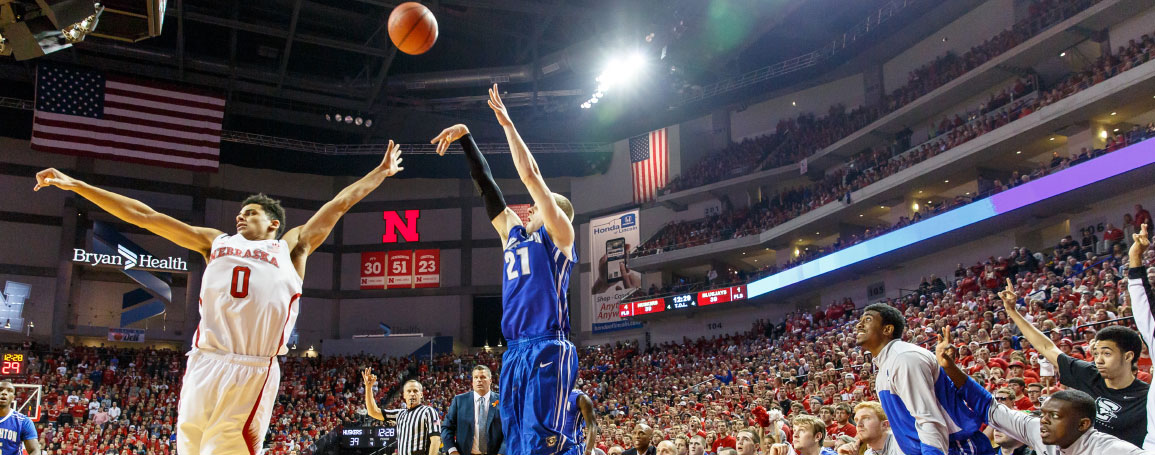[dropcap]In[/dropcap] Creighton’s three-game losing streak, which includes losses to North Texas, Providence, and Georgetown, the Bluejays have made 25.6, 23.8 and 20.0 percent from downtown, respectively — the first time that CU has shot worse than 26 percent from three-point range in three straight games since March 6-18, 2009. That was the second-to-last team of the Altman Era, and that stretch encompassed the near-meltdown against Wichita State in the MVC Quarterfinals (and Booker Woodfox’s subsequent heroics), the embarrassing loss to Illinois State the next day, and a first-round NIT win over Bowling Green.
This current stretch is the continuation of a season-long trend that has seen the Jays struggle to score. Because they’ve made three-point shots such a focus of their offense, even adopting Coach Mac’s phrase “Let It Fly” as a marketing slogan, their struggles from long range are an easy target.
15 games is half a season, and not really a small sample size anymore. So let’s examine where they’re at, and see what conclusions we can draw.
***
[dropcap]Just[/dropcap] four teams have attempted more three-pointers than Creighton. That’s nothing new; they took the third most three-pointers in the country last year, made the most, and had the highest shooting percentage from three-point range. Taking that many shots from long range made sense because they made them at a higher clip than anyone else. This year, 199 teams in D1 shoot a higher percentage from three-point range than Creighton, yet they continue to jack up threes at the same rate as they did when they had elite shooters.
How many shots are we talking about?
A year ago, 44.5% of their shots were three-pointers, accounting for 38.8% of their total points. This year, 46.1% of their shots have been three-pointers, accounting for 35.9% of their points. So they’re taking more three-pointers, but making a lot less of them — in 2013-14, they made 41.5% from long range, and this year they’ve made 33.2%. In simpler terms, in an average game last year, they took 24 three-pointers and made 10; this year, they take an average of 25 three-pointers a game and make 8.
Or put another way, three-pointers account for less of their offensive output, despite being a bigger part of their arsenal. The question is, after 15 games of stats and results, can they reasonably be expected to improve? Or is this who they are?
First, let’s look at last year’s numbers, but subtract the four seniors from the mix.
It’s not a perfect metric by a long stretch — surrounded by four stellar seniors, the pressure to make shots was less, and the shots they got were often a lot better than the shots they get this year — but it’s a start. The returning players attempted 219 three-pointers a year ago, and made 71. That’s 32.4%, or pretty damn close to the 33.2% Creighton is shooting as a team this year. Interesting.
Doing this individually is a better comparison, though. Again, it’s not perfect, but it’s worthwhile. Here’s the four returning players who made a three-pointer in 2013-14, and their numbers so far in 2014-15.
Austin Chatman
2011-12: 6-16 (37.5%)
2012-13: 35-83 (42.2%)
2013-14: 35-90 (38.9%)
2014-15: 21-71 (29.6%)
Isaiah Zierden
2013-14: 16-49 (43.2%)
2014-15: 40-97 (41.2%)
Avery Dingman
2011-12: 26-62 (41.9%)
2012-13: 33-83 (39.8%)
2013-14: 11-43 (25.6%)
2014-15: 6-18 (33.3%)
Devin Brooks
2013-14: 9-32 (28.1%)
2014-15: 9-40 (22.5%)
It’s a bit of a mixed bag. Chatman and Brooks are on pace to be more productive from three-point range overall but have taken more shots to get there, Zierden’s percentage has basically stayed the same while roughly doubling the number of shots he’s taken, and Dingman is slightly better than a year ago (but continuing to be significantly worse than either of his first two years).
Now, let’s add the only other player with D1 experience, and compare those numbers.
Rick Kreklow
2010-11: 13-46 (28.3%) *With Missouri
2012-13: 5-18 (27.8%) **With California
2013-14: 27-81 (33.3%) **With California
2014-15: 9-34 (26.5%)
Finally, let’s add the two new guys who have made a three-pointer.
Toby Hegner
2014-15: 24-68 (35.3%)
James Milliken
2014-15: 13-37 (35.1%)
Kreklow has been a bit worse than his numbers at Cal a year ago, but more or less in line with his career lines. Hegner’s 24 three-pointers are 8th best in the Big East, and 11 of those have come in the past five games as he’s settled into the offense. Milliken has been streaky, making 8 of his 13 three-pointers in three games and 5 in the rest. Tyler Clement is the only player to make a three, going 4-11 (36.4%) in a mix of mop-up minutes and emergency minutes at North Texas.
What can we make of this?
Based on career stats, Chatman could reasonably be expected to be better (perhaps much better) over the second half of the season than he’s been in the first half. Zierden is steady and can likely be counted on to continue to be an above-average shooter. Beyond that, it gets dicey. Kreklow might get a little better, but probably not much. Brooks and Dingman have probably already hit their ceiling, at least from three-point range. Hegner and Milliken are first-year players and both appear to be getting better the more they play, as their increased productivity in recent games shows, but probably won’t get much better this year.
In other words, the only player that you could predict to shoot better than he has is Chatman. Everyone else is basically performing at the level of their ability. For a team that continues to shoot more threes than almost any other team, hoping for improvement through making more threes seems to be an unlikely proposition. But with the inconsistent play of their big men, “Letting it Fly” remains their best hope of success this season.


